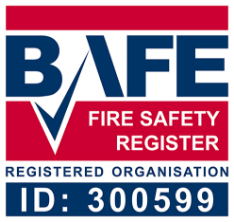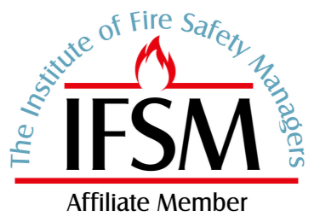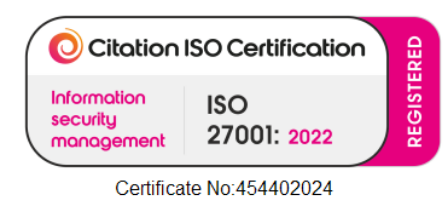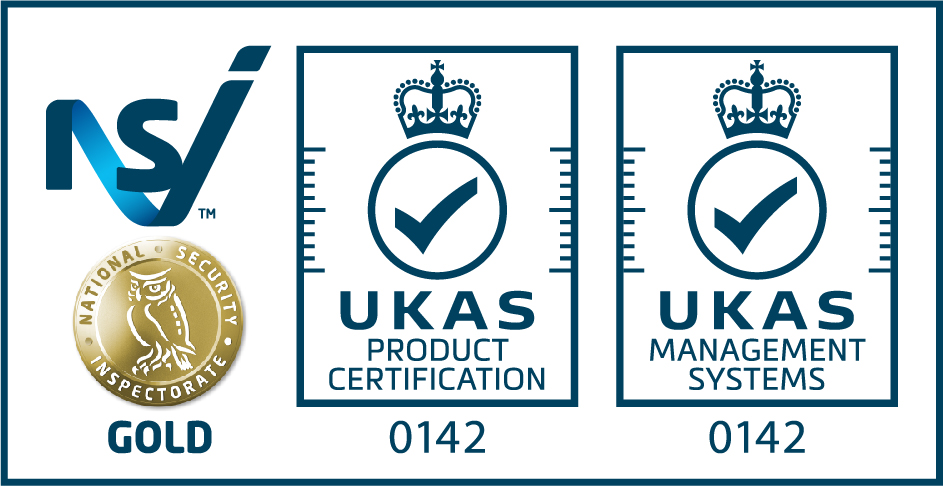Did you know that a neglected fire extinguisher inspection can turn a minor incident into a major disaster? In the UK, over 30% of workplace fire extinguishers are found faulty during annual checks, according to UK Fire Service Resources. Failing to carry out regular fire extinguisher inspection not only puts lives at risk but also exposes businesses to legal penalties and operational disruption. Routine fire extinguisher inspection offers peace of mind, ensures compliance with the latest regulations, and safeguards business continuity. In this guide, you will find a clear, step-by-step approach to fire extinguisher inspection for 2025, covering legal duties, inspection procedures, common issues, and best practices.
Understanding Fire Extinguisher Inspection: Why It Matters in 2025
Staying up-to-date with fire extinguisher inspection is crucial for every UK business in 2025. Regulations, safety standards, and the types of extinguishers in use are all evolving. Understanding these changes will help you protect people, property, and your organisation’s reputation.
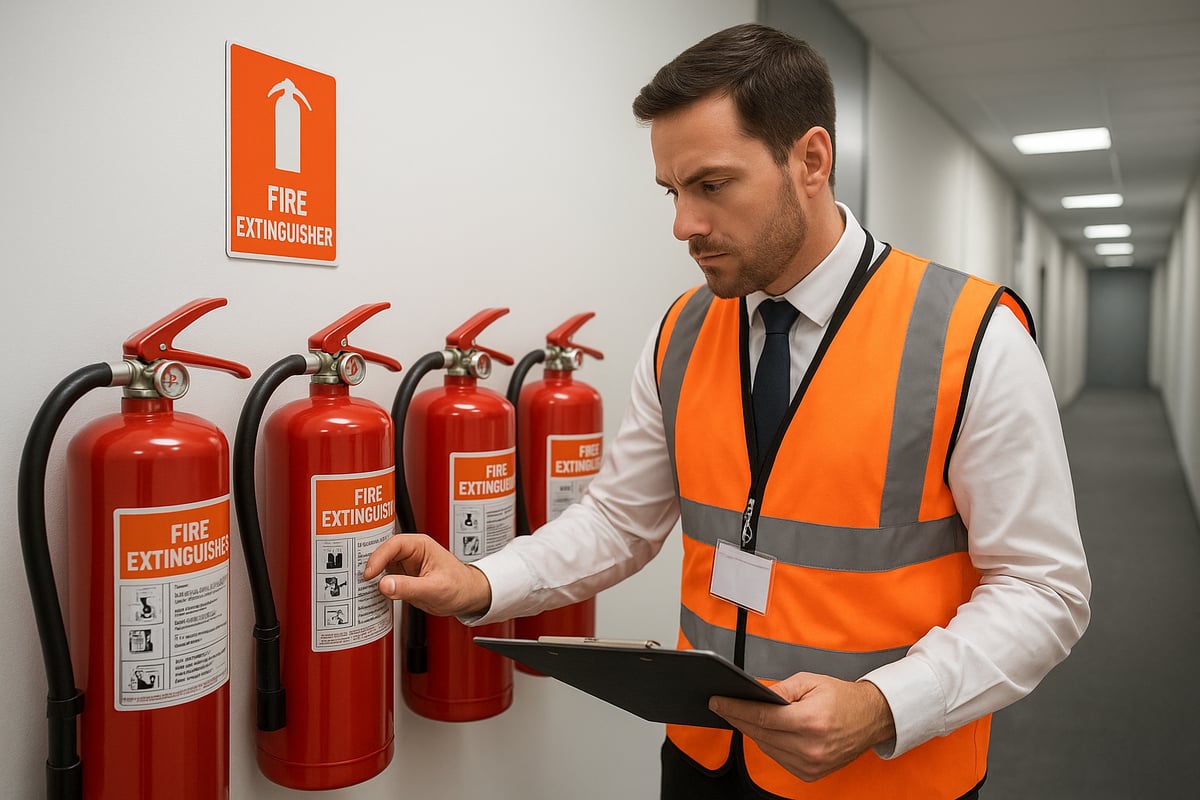
Legal Obligations and Regulatory Updates
UK fire safety law requires all workplaces to complete regular fire extinguisher inspection. The Regulatory Reform (Fire Safety) Order 2005 and BS 5306-3:2017 set the baseline for frequency and process. In 2025, new standards include changes to inspection intervals and the prohibition of certain chemicals. Failing to comply can lead to significant fines or prosecution. Authorities have increased enforcement actions, with several businesses fined in the past year for missing or incomplete records. It is vital to keep detailed inspection logs for insurance and audit purposes. For a summary of the latest changes, see the UK fire extinguisher regulation updates 2025.
The Role of Inspections in Fire Safety Strategy
A robust fire extinguisher inspection routine is a cornerstone of any effective fire safety strategy. Inspections identify faults before an emergency occurs, ensuring equipment is ready when needed. This reduces liability and protects building occupants. According to the Fire Industry Association, 80% of fires are controlled by portable extinguishers when used correctly. Consider a recent workplace incident where a routine inspection revealed a discharged extinguisher, which was replaced just days before a minor fire broke out. Regular checks can make the difference between a minor incident and a major loss.
Types of Fire Extinguishers and Inspection Needs
Several extinguisher types are commonly found in UK workplaces, each with specific fire extinguisher inspection requirements:
- Water: Check for leaks and corrosion.
- Foam: Inspect for nozzle blockages and pressure.
- CO2: Ensure the presence of intact pressure seals and weigh the cylinder.
- Powder: Shake to prevent powder settling and verify tamper seals.
- Wet chemical: Check specialist discharge mechanisms.
High-risk areas, such as kitchens or industrial sites, demand more frequent and thorough checks. For example, CO2 extinguishers need regular pressure gauge readings and hose inspections. Recent data shows powder extinguishers have a higher failure rate if left unchecked in damp environments. By tailoring your fire extinguisher inspection approach to the type and location, you significantly improve your fire safety compliance and readiness.
Step-by-Step Fire Extinguisher Inspection Process
Carrying out a thorough fire extinguisher inspection is essential for workplace safety and compliance. This step-by-step approach ensures no detail is missed, helping your business meet current UK regulations and best practices.
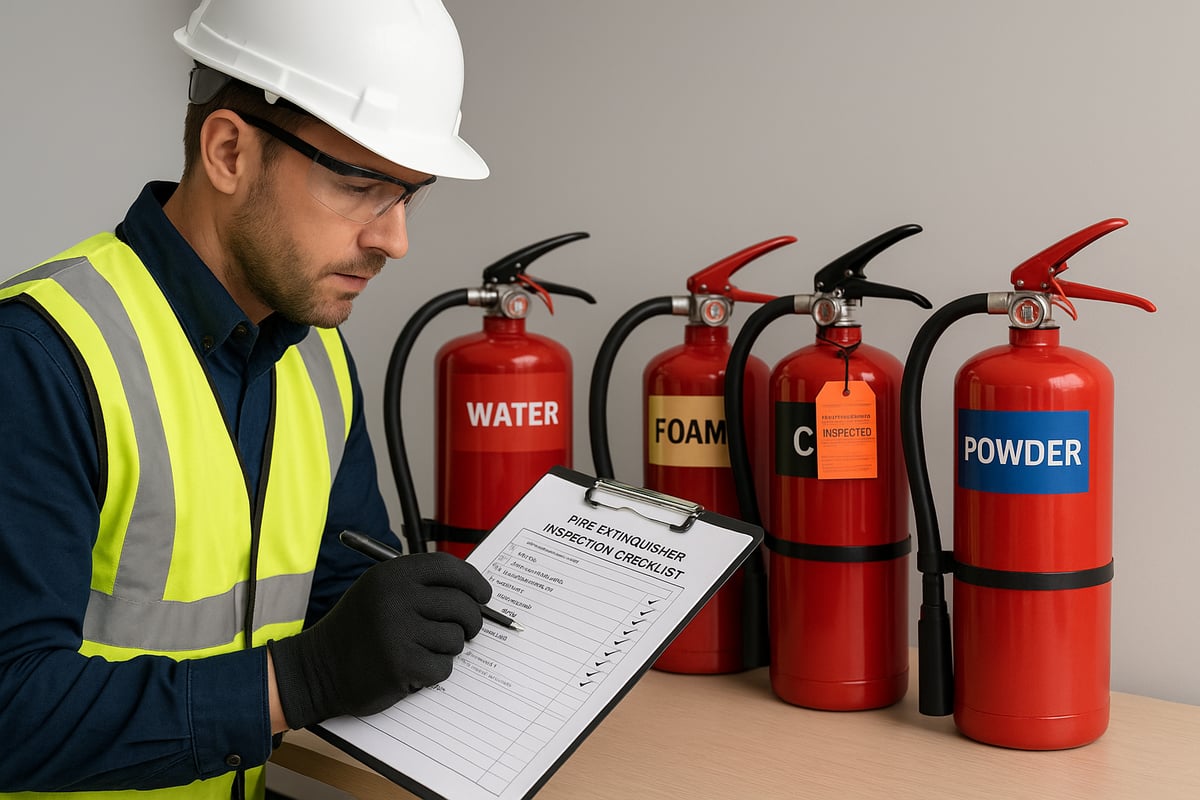
Pre-Inspection Preparation
Before beginning a fire extinguisher inspection, preparation is crucial. Start by scheduling both annual servicing and monthly visual checks as required by UK standards. Assign a competent person, as defined in BS 5306, to oversee the process.
Make sure all extinguishers are accessible. Gather the necessary tools such as a torch, inspection tags, and personal protective equipment. Review previous inspection records to identify recurring issues or missed checks.
A well-organised pre-inspection phase ensures consistency in every fire extinguisher inspection and supports legal compliance.
Visual Inspection Checklist
A detailed visual check forms the backbone of every fire extinguisher inspection. Confirm each unit has clear labelling and correct signage. Verify there is unobstructed access and that extinguishers are mounted at the correct height.
Inspect for any physical damage, corrosion, or leaks. Check the pressure gauge to ensure it is within the safe operating range. Confirm the presence of tamper seals and intact safety pins.
Common signs of neglect in office settings include faded labels, blocked access, and missing seals. For more on what to look for and how to address issues, see our Fire extinguisher servicing guide.
Functional Testing and Maintenance Tasks
Beyond visual checks, functional testing is a vital part of any fire extinguisher inspection. Weigh and pressure-test units where required, especially CO2 and powder models.
Shake powder extinguishers gently to avoid compacting the agent. Examine hoses, nozzles, and discharge mechanisms for blockages or wear. Replace, refill, or service extinguishers as needed, always following the manufacturer’s guidelines.
A missed pressure test once led to a failed extinguisher during a retail incident, underlining the importance of this inspection step. Each fire extinguisher inspection should include these functional tasks to guarantee readiness.
Documentation and Record Keeping
Accurate documentation is the final step in a compliant fire extinguisher inspection. Complete inspection tags and update logbooks immediately after each check.
Consider digital record-keeping solutions for 2025, which streamline audits and support insurance claims. Keeping detailed records of every fire extinguisher inspection protects your business and demonstrates diligence to authorities.
Common Fire Extinguisher Inspection Issues and How to Fix Them
Routine fire extinguisher inspection often uncovers issues that can compromise safety and compliance. Addressing these problems promptly ensures that extinguishers function correctly in an emergency and supports a robust fire risk management strategy.
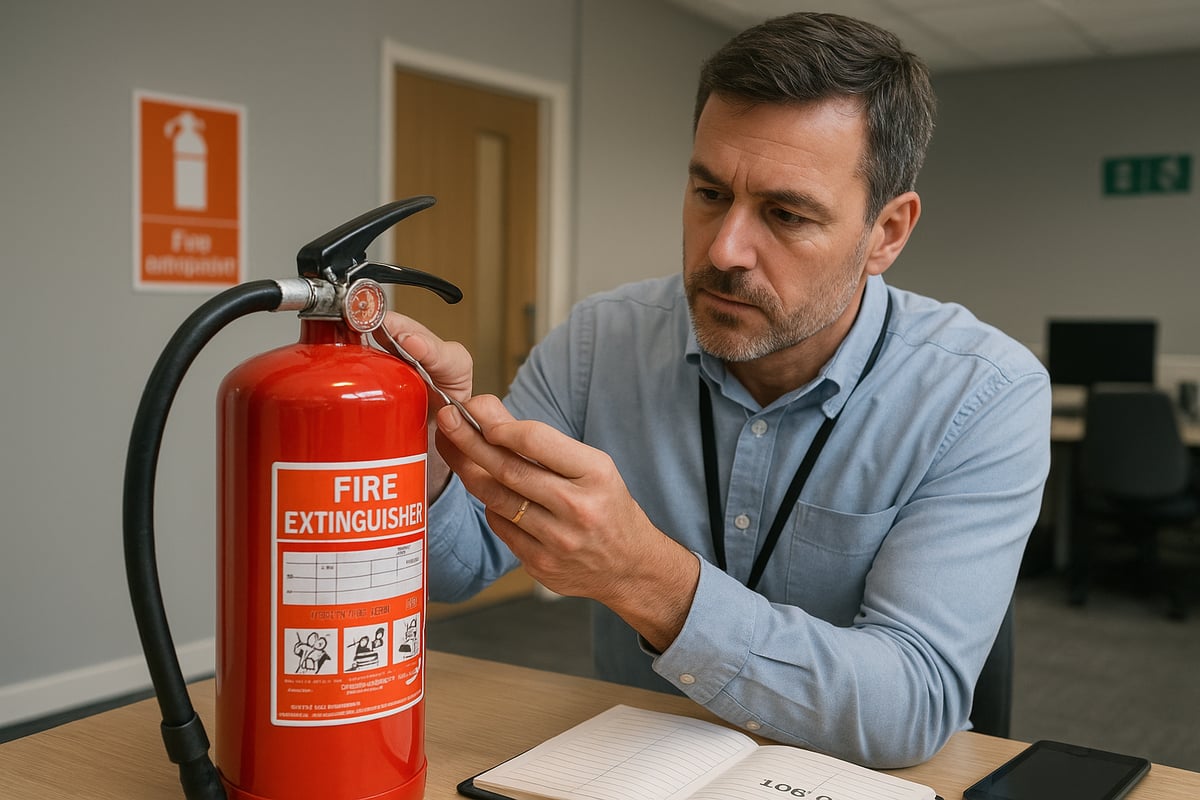
Frequent Problems Identified During Inspections
A fire extinguisher inspection will frequently reveal several recurring faults. The most common issues include:
- Expired or missing inspection tags: Without valid tags, it is impossible to verify the last check or maintenance date.
- Low pressure or empty extinguishers: These units may not discharge when needed.
- Blocked or damaged nozzles: Dirt, debris, or physical damage can prevent proper operation.
- Corrosion or physical damage: Rust, dents, or leaks can render extinguishers unsafe.
- Missing or broken safety pins: These compromise tamper evidence and safety.
Statistics indicate that expired tags and low pressure are the top faults found during fire extinguisher inspection in UK workplaces. For a comprehensive approach, integrating inspections with Fire risk assessment essentials is crucial, as this ensures no compliance gaps.
Solutions and Remediation Steps
When a fire extinguisher inspection uncovers faults, immediate action is vital. Follow these steps:
- Isolate faulty extinguishers: Remove any units that fail checks from service.
- Arrange for refilling or servicing: Empty or low-pressure extinguishers must be refilled or recharged by a certified technician.
- Repair or replace damaged parts: Address blocked nozzles, missing pins, or corrosion.
- Document all actions taken: Update inspection records and tags accordingly.
Preventative measures are equally important. Schedule regular maintenance, store extinguishers in suitable environments, and train staff to spot early signs of wear. In one logistics company, implementing scheduled servicing reduced inspection faults by 40 percent, highlighting the impact of proactive management.
Preventing Future Failures
Ongoing attention is key to reducing fire extinguisher inspection failures. Start with comprehensive staff training so everyone understands basic extinguisher care and reporting procedures. Regular housekeeping checks ensure extinguishers remain accessible and undamaged.
Integrate fire extinguisher inspection into wider safety audits for a holistic approach. Technology also plays a vital role in 2025. Use QR codes or mobile apps to set automated reminders, track inspections, and maintain digital logs.
A recent case study from a UK school illustrates the benefits: after moving to digital inspection records, missed checks dropped significantly, and compliance improved. Consistent attention to process and technology will keep your fire extinguisher inspection procedures robust and reliable.
Best Practices for Fire Extinguisher Compliance in 2025
Ensuring robust fire extinguisher inspection compliance in 2025 is not just about ticking boxes. It means creating a culture of safety, staying ahead of regulation, and using the right people, processes, and technology. Here is how to embed best practices into your fire safety routine.
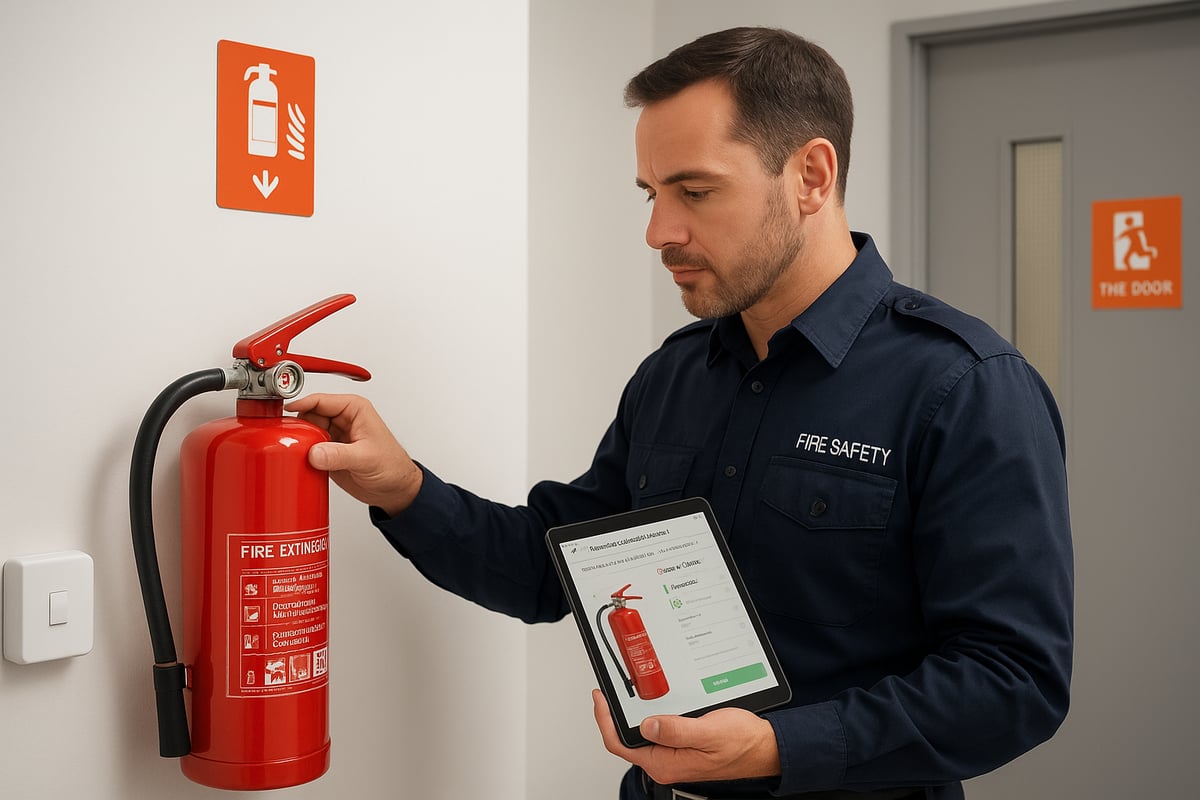
Training and Appointing Competent Persons
A key pillar for effective fire extinguisher inspection is appointing a “competent person”. Legally, this is someone with adequate training, knowledge, and experience to carry out inspections as defined in British Standards. Regular refresher courses and professional development are vital to maintain competence and adapt to updated regulations.
Essential training elements include:
- Understanding different extinguisher types and their inspection needs
- Recognising signs of wear, damage, or tampering
- Completing and maintaining accurate records
Certification from recognised bodies, such as the Fire Industry Association (FIA), is highly recommended. Many businesses benefit from enrolling staff in FIA-accredited training programmes, which cover both theory and hands-on skills. Investing in ongoing education ensures your team remains up to date and inspection-ready.
Scheduling and Frequency Guidelines
A structured schedule is the backbone of fire extinguisher inspection compliance. Monthly visual checks, combined with annual servicing by a competent person, form the minimum standard. In high-risk settings, such as kitchens or manufacturing plants, inspections may need to be more frequent to ensure readiness.
| Frequency | Activity | Responsible Person |
|---|---|---|
| Monthly | Visual inspection | Trained staff |
| Annually | Full servicing | Competent person |
| As required | After use or incident | Certified technician |
Coordination with other fire safety checks, like fire alarm system requirements, boosts overall compliance and reduces missed steps. For example, a manufacturing plant might align extinguisher checks with routine fire alarm tests to streamline safety audits and maintain complete coverage.
Leveraging Technology for Compliance
Digital transformation is reshaping fire extinguisher inspection in 2025. Mobile apps and cloud-based systems allow for real-time recording, automated reminders, and instant access to inspection history. QR codes and NFC tags attached to extinguishers mean staff can scan and log checks quickly, improving accuracy and accountability.
A recent survey of UK facility managers revealed a sharp increase in the adoption of digital inspection tools, with many citing improved audit readiness and fewer missed inspections. Integrating technology not only supports legal compliance but also future-proofs your approach as regulations and best practices evolve. By embracing digital solutions, businesses can ensure every fire extinguisher inspection is thorough, timely, and fully documented.
Frequently Asked Questions About Fire Extinguisher Inspections
Navigating fire extinguisher inspection requirements can be confusing, especially as regulations evolve. Here are answers to the most common questions UK businesses ask about fire extinguisher inspection, legal compliance, and best practices for 2025.
Who Can Perform Fire Extinguisher Inspections?
For a fire extinguisher inspection, only a “competent person” should carry out the process. This means someone with suitable training, knowledge, and experience in fire extinguisher servicing, as defined by BS 5306-3.
Internal staff may conduct basic monthly checks if they have received proper training. However, annual servicing must be completed by an external certified technician or a person with recognised qualifications. If an unqualified individual performs fire extinguisher inspection, it could invalidate insurance and expose the business to legal risk.
What Records Must Be Kept?
Accurate record keeping is essential for every fire extinguisher inspection. Legally, businesses must maintain up-to-date records of all inspections, servicing, and maintenance. This includes inspection tags on each extinguisher and a central logbook or digital record.
Records should detail the date, findings, actions taken, and who completed the fire extinguisher inspection. The law requires these records to be retained for several years, as they may be requested during audits, insurance claims, or enforcement visits.
How Often Should Inspections Be Carried Out?
The frequency of fire extinguisher inspection depends on the type of check. UK regulations require a visual inspection at least once a month, with a full service by a competent person at least annually.
For high-risk environments or where extinguishers are heavily used, more frequent inspections may be necessary. Always refer to the manufacturer’s guidelines and your fire risk assessment to determine if adjustments are needed. Regular fire extinguisher inspection ensures equipment is ready when needed and supports compliance.
What Should I Do if an Extinguisher Fails Inspection?
If a fire extinguisher inspection reveals a fault, take it out of service immediately. Place a clear “do not use” sign on the extinguisher and arrange for a certified technician to repair, refill, or replace it as required.
Do not attempt repairs unless qualified. If multiple extinguishers fail, review your maintenance schedule and staff training. Prompt action following a failed fire extinguisher inspection helps maintain safety and legal compliance, reducing the risk of equipment failure during an emergency.
How Do Inspections Fit Into Overall Fire Safety Compliance?
Fire extinguisher inspection is just one part of a comprehensive fire safety strategy. Inspections should be integrated with fire risk assessments, emergency plans, and other safety checks, such as fire door inspection best practices.
Keeping thorough records of every fire extinguisher inspection supports insurance claims and demonstrates due diligence during audits. Regular inspections, combined with wider safety measures, help protect people, property, and business continuity.
After reading through the essential steps for effective fire extinguisher inspections in 2025, you might be wondering how your own site measures up or whether your compliance strategy covers every angle. With so much at stake—safety, legal obligations, and peace of mind—it’s worth getting a professional perspective. At Logic Fire and Security, we specialise in providing tailored fire safety solutions that keep your team and premises protected. If you’d like expert advice or a thorough review of your current setup, you can Get a Free Site Survey from our knowledgeable team.



